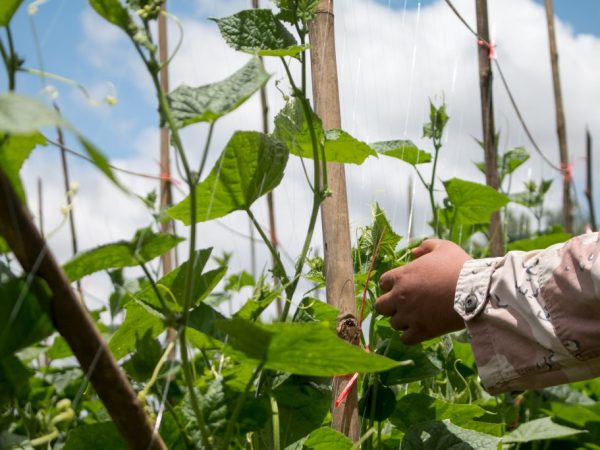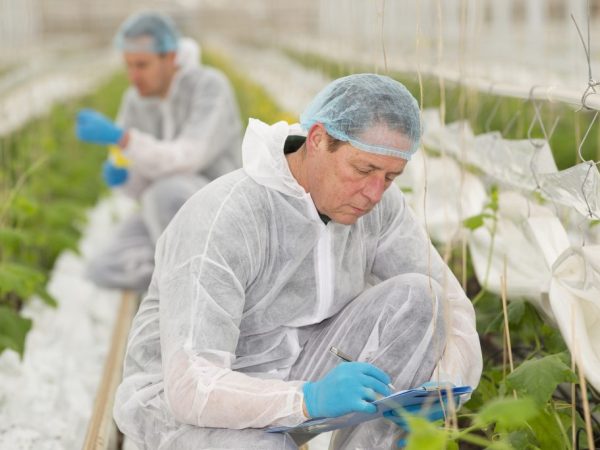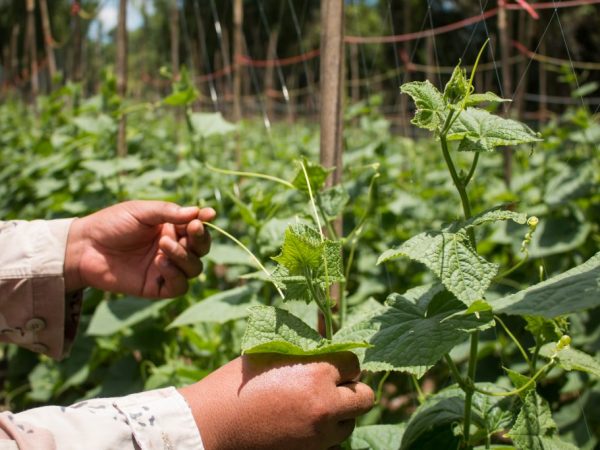Diseases of cucumber seedlings and their treatment
Diseases of cucumber seedlings cause a lot of trouble for summer residents, leading to the death of young companies at the stage of their initial development. Timely measures taken help to save the seedlings and preserve them for future planting in a greenhouse or open ground.

Diseases of cucumber seedlings and their treatment
Yellowed foliage
Causes
The main causes of yellowed foliage of cucumber sprouts are fungal pathogens and pests. However, among other reasons for yellowing of seedlings, sometimes improper care of cucumbers also becomes:
- cramped and insufficient space - actively growing cucumber bushes require a lot of space every day, and the root system requires more mineral nutrition,
- lack of sufficient feeding, especially nitrogen, potassium and magnesium, leads to the fact that the seedlings begin to hurt,
- inadequate lighting, or vice versa, installing a container with planted cucumbers in places with direct access to the sun leads to yellowness of the leaf blades of cucumber sprouts.
Prophylaxis
Comprehensive care of cucumber seedlings prevents the development of yellowed leaf disease.
Food
It is possible to compensate for the deficiency of trace elements by applying fertilizers and dressing. Among the fertilizing complexes are Vermistim and Azogran. With a lack of potassium, watering with ash infusions helps. Yellow leaves respond well to onion infusions, which are made from 50 g of onion husks with 10 liters of water, boiled, cooled and watered cucumber plantings with a strained warm working solution.
Picking
At the stage of formation of the root system in young shoots, it is required to transplant seedlings in larger containers. A pick is done when the first 2-4 leaves appear.
Withering
Fusarium and verticillary wilting of young cucumber seedlings is often associated with damage to plants by soil fungus that penetrates into the root system and destroys the shoots from the inside. As a result, the growth and development of the cucumber crop is suspended. Initially, the upper part of the seedling withers with a loss of elasticity, but in some cases the pathogenic fungus causes the death of the entire plant as a whole. It is possible to detect the presence of a fungus on a cut of the root in the form of brown rings.
Dry air and temperatures exceeding 25 ° C-28 ° C become favorable conditions for the development of a pathogenic fungus, leading to fusarium wilting, while for verticillary wilting, increased humidity and a temperature not higher than 16 ° C-20 ° C are needed.
Prophylaxis
Decontamination of the soil and thorough cleaning of the beds from past plant debris when the seedlings are planted in the greenhouse helps to cope with wilted foliage and prevent the death of plants. Phytosporin, planriz and trichodermin help to get rid of the pathogenic fungus. These preparations are used to water the soil 7 days before the planting of seed or seedlings.
Rot

We fight the disease
Improper care of cucumber plantings often leads to the fact that the seedlings of cucumbers are sick with rot, after which the seedlings die.
Gray
Gray rot appears when there is an excess of moisture and due to watering the seedlings with cold water in conditions of too dense plantings of cucumber bushes. Among the initial signs - a slippery gray coating, covered with gray fluff.
Prophylaxis
In the fight against gray mold, it helps:
- airing the greenhouse when the seedlings are grown indoors,
- cessation of watering for 2-3 days,
- cutting off damaged parts with dusting the sections with ash or chalk powder,
- removal of diseased seedlings and spraying the remaining healthy ones with phytosporin, oxychom, trichodermine in case of extensive lesions.
Root
When seedlings become diseased with root rot, their root system becomes brown, then the root collar becomes too thin, dries up and dies off. As a result, the plant dies.
Root rot can be caused by a violation of the rules for watering seedlings, sudden temperature changes, excessively deep planting of seed and excessively dense planting of sprouts.
Prophylaxis
At the first signs of measles rot, the earth is raked off the stems, the root system is treated with disinfectant solutions. As a treatment for disinfection, a mixture of 2-3 large tablespoons of copper sulfate, 6 large beds of ash powder or limestone per liter volume of water effectively acts.
The roots of the seedlings are sprinkled back with earth only after they have completely dried out after disinfecting.
Blackleg
A fungal disease of cucumber seedlings, the black leg manifests itself in plants in the form of black formations in the area of the base of the stem. The fungal pathogen clogs the blood vessels and becomes a barrier for mineral nutrition to the roots. As a result, cucumber seedlings die, bending towards the surface of the earth.

Defining the disease
Among the main reasons for the appearance of a black leg are planting density, violation of illumination and sudden temperature changes.
Prophylaxis
Pre-sterilization of the soil mixture helps to prevent the development of blackleg fungus in the soil. Before use, it is steamed in an oven, after which it is treated with a disinfectant solution for 2-3 hours. Ash powder or sand is mixed into the soil before planting the seeds. Trichocin, Previcur and Glyocladin are helpful as a disinfectant.
Mosaic
Cucumber mosaics can have several varieties, but all of their pathogens are carried by insects, often aphids and whiteflies. In some cases, the cause of the cucumber mosaic is contaminated seed. With mosaic disease of cucumber seedlings, the photo shows an unusual pattern on the foliage of cucumber seedlings.
Field
Aphids bring a field mosaic to cucumbers. Field mosaic viruses persist throughout the winter in the roots of weeds. As a result of the disease, the foliage of the seedlings is covered with a yellow-green mosaic pattern. Subsequently, the infected leaves begin to curl, dry out and fall off after a while. The seedlings weaken and, with a decrease in heat, stop their growth and die.
Prophylaxis
In order to prevent field mosaics, spraying with serum with a concentration of 50%, diluted with water 1: 1, or phytosporin is carried out.
White and green
With a white mosaic, the foliage of the cucumber culture is covered with white spots with a yellow tint, merging into a single large spot, with green leaves, the leaves wrinkle and become light-spotted. The causes of white and green mosaics, transmitted through infected seed material, soil and plant debris, are a sharp drop of up to 30 ° C and above.
Prophylaxis
Against the white and green mosaic, the seed material is preliminarily heated and etched before planting.Diseased seedlings are sprayed with serum, removing damaged shoots.
Powdery mildew
Powdery mildew on cucumbers usually develops in closed greenhouses. Its fungus initially settles on the foliage of cucumber seedlings, subsequently moving to all other parts of the plants. As a result, the seedlings begin to lag noticeably in their development.
The reasons for the appearance of powdery mildew are irregular irrigation, oversaturation of the soil with nitrogen and a lack of potassium in the soil.
Prophylaxis
Horsetail and marigolds have a detrimental effect on powdery mildew, from which infusions are made for watering affected seedlings. For the treatment of a fungal disease, fungicidal preparations containing Bordeaux liquid, copper and iron are used. The foliage of cucumber seedlings is treated on both sides, with repeated spraying after a week.
Peronosporosis
Downy mildew has some other signs, appearing on the outer side of the leaf blade in the form of oily yellow spots along the central leaf vein, and on the inner side - in the form of a gray spore bloom. As a result, the leaves become dark in color, their tissue is destroyed.
Prophylaxis
For the prevention of downy mildew disease, seed material is disinfected with zinc sulfate, heated to 50 ° C. Among the folk remedies for the treatment of peronosporosis are milk serum, a solution with mullein, and soap and soda liquids.


